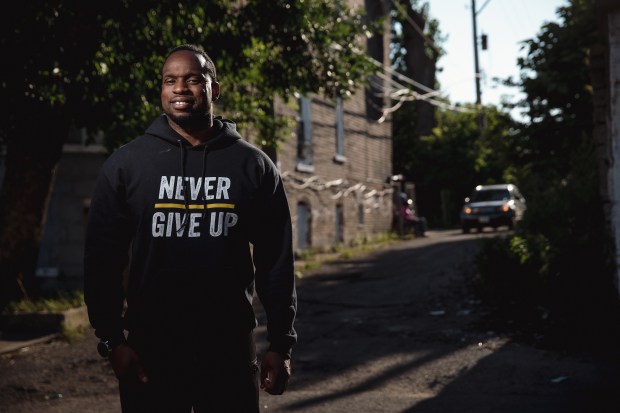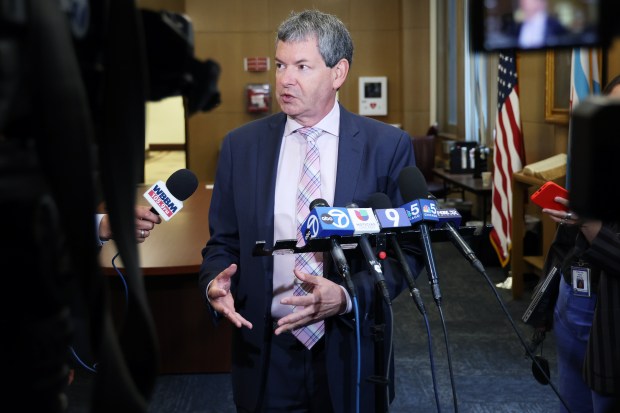Damien Morris was feeling “a little tense” Wednesday afternoon. It was the first day of a planned six-day sprint to prevent as much violence as possible in East Garfield Park and Morris, chief program officer for violence prevention and social services nonprofit Breakthrough, was staring down a packed calendar.
Memorial Day, the unofficial start of summer, historically marks the beginning of an annual spike in violence that the city has done its best to shake for decades. Like many other organizations that help prevent and respond to violence around city neighborhoods, Morris and his team have scheduled extra shifts days in advance of the holiday to make sure workers can help defuse conflicts as they occur.
The goal, he said, is “to report zero for East Garfield Park.”
That effort has some momentum coming into the summer: Mayor Brandon Johnson, police Superintendent Larry Snelling and other officials all hailed recent dips in homicides, shootings and robberies at a Thursday news conference.
But the city still faces real-time public safety challenges, perhaps most notably the stalled debate over how to best address large so-called teen takeovers that have sometimes resulted in gunfire. And while city and state leaders support funding for neighborhood violence intervention groups, cuts from the U.S. Department of Justice have drawn millions away from some of those organizations.
Soledad Adrianzén McGrath, executive director of the Northwestern University neighborhood safety research center CORNERS, said that Chicago has a strong local network built up to respond to violence around its neighborhoods. But there is more to be done to expand and reinforce that work, she said, and pandemic-era programs need to find a way to keep operating now that the initial cash infusions have largely dried up.
“If you don’t have the dollars to even sustain the infrastructure that’s already out there, that’s where we’re going to start to see some fraying,” she said.
Johnson, flanked by members of the City Council, agency heads and his own public safety administrators at a Thursday news conference, called on Chicagoans to “stand shoulder to shoulder” against violence over the coming months.
“Historically, the summer months bring both joy and pain to our communities,” Johnson said. “We need everyone to rally together in this moment to contribute to a safer, stronger city.”
Johnson and other officials Thursday emphasized both preparedness activities such as gun-safety awareness workshops and diversions, including athletic activities and youth job opportunities, to offer Chicagoans, and young people in particular, productive ways to spend their free time.
Two large, chaotic teen gatherings in Streeterville that ended in shootings have pushed some to search for ways to prevent so-called teen takeovers. Leading the charge is Ald. Brian Hopkins, 2nd, who revived efforts to install an earlier downtown curfew first launched after similar events last year.
Hopkins later pushed instead to give the police superintendent and deputy mayor for community safety the power to declare three-hour “snap curfews” anywhere in the city when authorities anticipate gatherings. But though his ordinance once appeared sure to pass, his decision to place the curfew power solely in the superintendent’s hands has given some aldermen pause over concern it gives the superintendent too much leeway.
Hopkins’ ordinance was stalled by opponents in the City Council this week. The downtown alderman promises a vote next month and says the “snap curfew” ordinance has enough support to pass. But even if it does, the threat of a veto from Johnson — who has criticized the newer superintendent-only version as an overreach — still looms.
He has also praised the Johnson’s administration and police department’s efforts to prevent the “takeovers” from occurring in recent weeks.
Snelling, speaking Thursday, said the department’s goal was to “get into it before it starts” and prevent fights or shootings. While police would not “arrest our way out” of volatile gatherings of any kind, Snelling warned there would be moments when arrests were unavoidable.
“We’re doing every single thing that we can to keep the city safe and do it constitutionally,” he said.
The “takeovers” that have attracted the most attention have been in highly visible areas near downtown. Away from the Loop, organizations that serve just one or a handful of neighborhoods shoulder much of the work meant to stop violence before it begins. Their success depends in large part on whether they are able to create meaningful relationships with the people in the areas they serve.
Morris, of Breakthrough in East Garfield Park, said that while his team was in high gear for immediate needs around their area for the holiday weekend, much of their work year-round was about being a “consistent presence” with residents through regular events, dinners and canvasses. That work is typically paid for using a combination of city, state and private philanthropic dollars. But some organizations that were getting funds from the U.S. Department of Justice have seen that money evaporate.

Breakthrough, which runs two shelters, permanent supportive housing and a number of other social service programs alongside its violence prevention work, has so far avoided the worst of the turbulence.
Others, such as the North Lawndale-based UCAN, have taken direct hits. UCAN lost $200,000 it had been using for its victim advocates program, according to CEO Christa Hamilton. And earlier this month, Metropolitan Family Services, which helps fund dozens of violence prevention groups through its Metropolitan Peace Initiatives, lost $3.7 million in Department of Justice funding that was earmarked for three organizations.
Metropolitan Peace Initiative Executive Director Vaughn Bryant said that sum covered “money we weren’t able to spend” for the remainder of the current fiscal year and some “new” money that would have gone to fund other groups.
Metropolitan Family Services plans to appeal the termination, he said.
At the state level, anti-violence workers and advocates are pushing for continued support of FLIP, a block-level outreach program that places workers from the neighborhood in “hotspots” to leverage their own relationships to try to prevent and de-escalate conflict that might otherwise turn deadly.
CORNERS, the Northwestern neighborhood safety research center, recently released a report that found a 41% overall drop in shooting victimizations at hotspots where peacekeepers were working over 2023 and 2024 compared with the preceding two years.
Gov. JB Pritzker’s proposed budget included $40 million to continue violence prevention services through the Reimagine Public Safety Act, which was previously funded primarily through federal pandemic relief dollars and has awarded nearly $260 million since 2021 in an effort to prevent gun violence, according to Pritzker’s office.
The budget proposal would also fund the same amount in community-based violence prevention programs as this fiscal year, about $16 million. The state anticipates serving close to the same number of people with such programs this year as it did last year, according to the proposal.
How Illinois will fund violence prevention — and the entire state budget for the upcoming fiscal year — is subject to a negotiation process in the General Assembly that’s currently in its home stretch ahead of a May 31 deadline.



